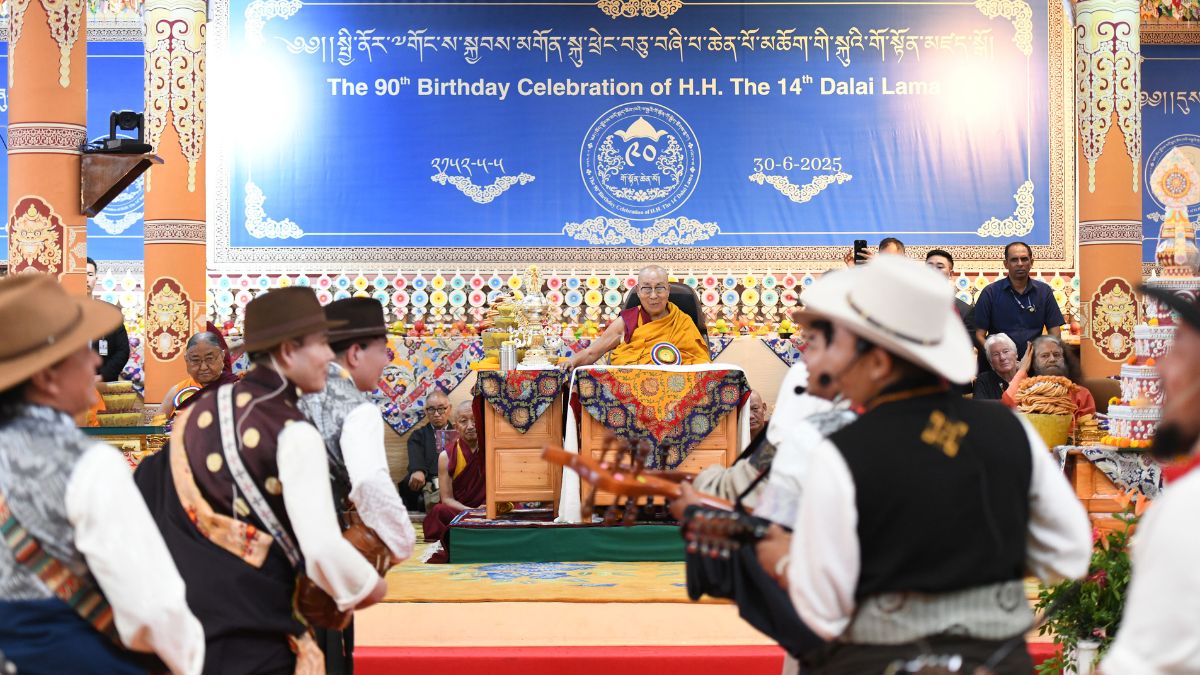Of God, culture and identity: McLeodganj comes alive as Dalai Lama turns 90

It is a foggy morning in Dharamshala, Himachal Pradesh, with the rain pouring relentlessly, colouring the town grey.
58-year-old Ott Hans-Jurgen sits inside the Dalai Lama Temple (or Tsuglagkhang), absorbedly reading 'The Kalachakra Mandala' by Edward Henning. Tattooed on his right arm is the powerful Tibetan Buddhist mantra: “Om Mani Padme Hum”.
Hans-Jurgen has travelled from Germany to McLeodganj, where the 14th Dalai Lama (the head of Tibetan Buddhists) is based, to take part in the spiritual leader's birthday celebrations. The Dalai Lama will be turning 90 on Sunday (July 6). "I just want to catch a glimpse of His Holiness," he says fondly.
While usually bustling with tourists, McLeodganj, a tiny suburb in Dharamshala, is currently abuzz with a different kind of energy as it is witnessing the Dalai Lama’s birthday celebrations, which began on June 30, in accordance with the Tibetan calendar.
"We offer our devotion that the Dalai Lama, protector of the Land of Snows, lives for one hundred eons," a group of brown-robed monks sing at the celebrations. "May all your noble aspirations be fulfilled," they add.
"We had a great celebration at His Holiness' 80th birthday. At that time, he said his 90th birthday should be such," says Yeshi Dolma, vice president of the Goton—a word that the Tibetan community uses to refer to the Dalai Lama's birthday—on Monday.
The sheer importance of the celebrations is palpable as hundreds of brown-robed monks can be seen taking part in making arrangements for the festivities—from climbing up the ladder to fix a make-shift tent to serving the traditional Tibetan butter tea to the devotees, and also sweeping the premises.
"He's the Dalai Lama. He's our God," a monk, taking part in arranging for the celebrations, says.
In an interesting turn, the grand celebrations have also become a medium for people to share their memories of the Dalai Lama. While an octogenarian monk who fled Tibet and came to India on foot fondly calls the Dalai Lama "Guruji", and teaches attendees about the intricacies and customs of Tibetan Buddhism, Loten Namling, a singer born in Dharamshala and currently based in Switzerland, shares an interesting incident.
"Once the Dalai Lama was visiting Leh, Ladakh, and as I was there among the devotees, he came to me, and pulled my beard playfully. While he walked away, the locals surrounded me and asked me to bless them as His Holiness had touched my beard. Seeing people's devotion, I haven't cut my beard since then," he shares. Namling is also in Dharamshala for the Dalai Lama's birthday.
In fact, many Tibetans spread all across the world have travelled to India from countries such as Canada, Switzerland, Germany, and Singapore. Several monks from India, Sri Lanka, Thailand, and Cambodia have also travelled to the Himalayan town.
Mukesh Ratan, who has taken up the brown Buddhist robe only recently, has travelled from Kannauj. "I've come because of the Dalai Lama. He's like the Buddha," he says.
While the celebrations hold spiritual and religious significance, the importance of the Tibetan identity here is also apparent. Tibetans, who have travelled from across the world, can be seen in their traditional chuba, an ankle-length robe, in various fabrics (but mostly silk), showcasing Tibet's place in the ancient Silk Road.
The diversity within Tibet—which comprises three regions: U-Tsang, Kham, and Amdo—is also apparent, as people sing and dance to the local tunes, and wear traditional attire, at the leader's birthday celebrations on Monday.
The Dalai Lama is at the centre of this identity for the people, who have held onto their religion, language, and culture while having been long exiled from their homeland. “Yes, the Dalai Lama is our spiritual head, but he’s so much more,” says 40-year-old Tashi, who has travelled to India from the Netherlands. “He’s our identity," she adds.
Meanwhile, a little farther from the Dalai Lama Temple, at the Tibet Museum, several Tibetans, who have travelled to McLeodganj can be seen educating their young kids about their homeland's troubled past. Right outside, young boys and girls, holding guitars, can be seen singing and practising to perform at the Dalai Lama's birthday celebrations.
The atmosphere is merry, even as museum walls at the back display many Tibetan monks who self-immolated to protest against political oppression and religious persecution at the hands of the Chinese government. It was in 1959 that the 14th Dalai Lama fled Tibet and took refuge in India, following a failed uprising against China.
While his 90th birthday celebrations have also been seen as crucial with respect to his succession plan, for the Tibetans, the question, of who will become the next Dalai Lama brings some nervousness but also hope, as they are praying for the monk's longer life. “I hope he lives for 113 years as he has promised us,” says Tashi, with both hope and devotion apparent in her voice.
Society